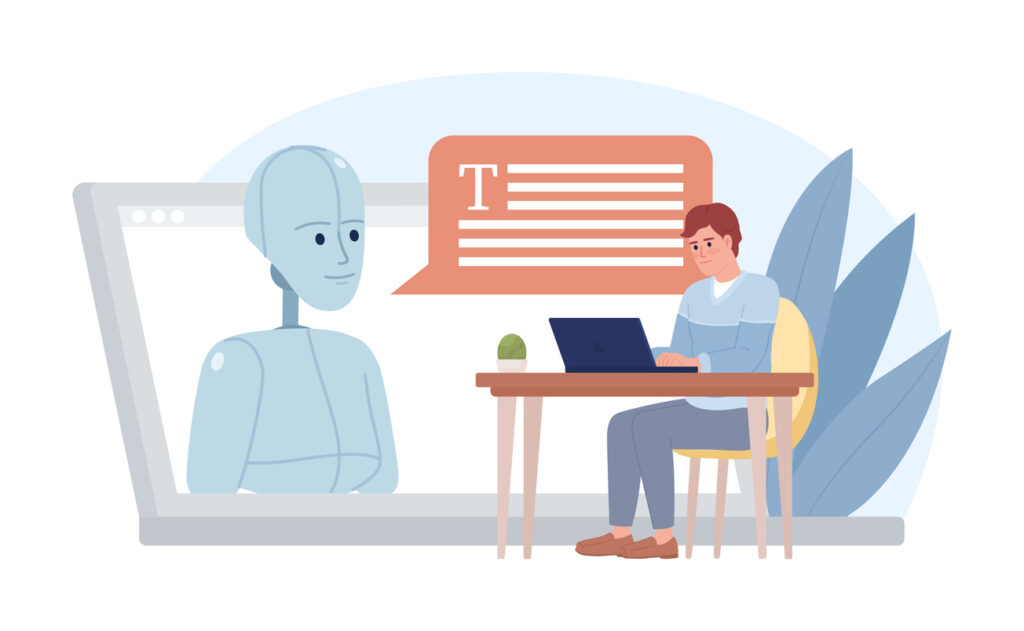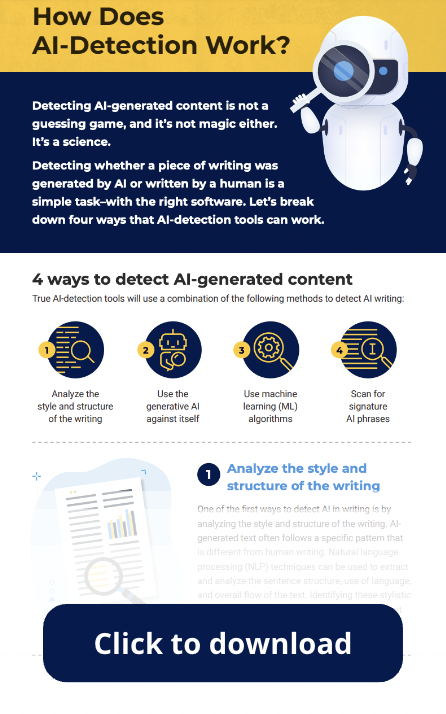How Does AI Detection Work for Universities?
Now that tools like ChatGPT are readily available to the public, many are wondering the same question: how will we know if content was written by AI or written by a human?
Detecting AI-generated content is not a guessing game, and it’s not magic, either. It’s a science.
Detecting whether a piece of writing was generated by AI or written by a human is a simple task–with the right software. Let’s break down four ways that AI detection tools can work.
4 ways to detect AI-generated content
True AI detection tools will use a combination of the following methods to detect AI writing:
- Analyze the style and structure of the writing
- Use the generative AI against itself
- Use machine learning (ML) algorithms
- Scan for signature AI phrases
1. Analyze the style and structure of the writing
One of the first ways to detect AI in writing is by analyzing the style and structure of the writing. AI-generated text often follows a specific pattern that is different from human writing. Natural language processing (NLP) techniques can be used to extract and analyze the sentence structure, use of language, and overall flow of the text. Identifying these stylistic and structural patterns can help identify whether it was written by a human or generated by AI.
2. Use the generative AI against itself
Another method takes state-of-the-art large language models with similar capabilities and order of parameters to Open AI models, asking it to predict how likely it is to generate a given text as an indicator of AI involvement.
3. Use machine learning (ML) algorithms
ML algorithms can be trained to recognize the differences between human writing and AI-generated writing. By analyzing a large corpus of text, the ML algorithm can learn to identify patterns in the text that are indicative of AI-generated writing.
4. Scan for signature AI phrases
Many AI-generated texts use specific phrases consistently when responding to questions, writing emails, or filling out applications. For example, ChatGPT tends to say “Here are the steps” when explaining a process, or “AI assistant” to refer to itself. By filtering for these signature phrases, it is possible to improve accuracy over whether a text was generated by an AI.
How does AI Detection work?

By analyzing the style and structure of the text, using NLP techniques, ML algorithms, and scanning for signature AI phrases, Scaffold AI Detection powered by GPTZero combines these techniques to provide the most accurate and robust tool to detect AI in writing.
Scaffold AI Detection works across a range of AI language models, including but not limited to ChatGPT, GPT-4, GPT-3, GPT-2, LLaMA, and AI services based on those models. In addition, this tool is the first AI detection model to be fine-tuned for the educational use case with additional data from student writing.
Can universities detect AI writing?

By using Scaffold AI Detection, universities are able to analyze thousands of student submissions at once for potential AI-generated content, including:
- Quizzes,
- Tests,
- Assignments,
- Online discussion posts,
- Essays
- File attachments
- And more.
Institutions will receive daily reports indicating a percentage of AI usage likelihood across the entire learning ecosystem. In other words, faculty and staff will not need to scan submissions one by one to check for possible AI-generated content. Scaffold AI Detection can even give insight into individual students who have a high percentage of AI-style writing in submissions.
This solution provides schools with the most accurate results to help maintain academic integrity.
How will your school respond to artificial intelligence tools? Speak with one of our experts to learn more about how AI Detection works and determine if this solution is right for your institution.



